Evaluation of HR and Line Managers in People Management, Recruitment
VerifiedAdded on 2020/02/03
|17
|5303
|34
Report
AI Summary
This report delves into the crucial relationship between HR managers and line managers within organizations, emphasizing their collaborative roles in effective people management, particularly in recruitment and selection processes. It critically evaluates the responsibilities of HR managers, including strategic and functional duties, employee guidance, compensation, training, and development, as well as the importance of recruitment and selection. The report also explores the roles of line managers in enhancing employee engagement, implementing performance appraisals, and maintaining workplace discipline. Furthermore, it analyzes the advantages and disadvantages of internal and external recruitment methods, highlighting the significance of ethical considerations in selecting candidates. The report references various models and theories from authors to illustrate the recruitment and selection process. This report provides valuable insights for students and professionals seeking to understand the dynamics of HR and line management in the contemporary business environment.
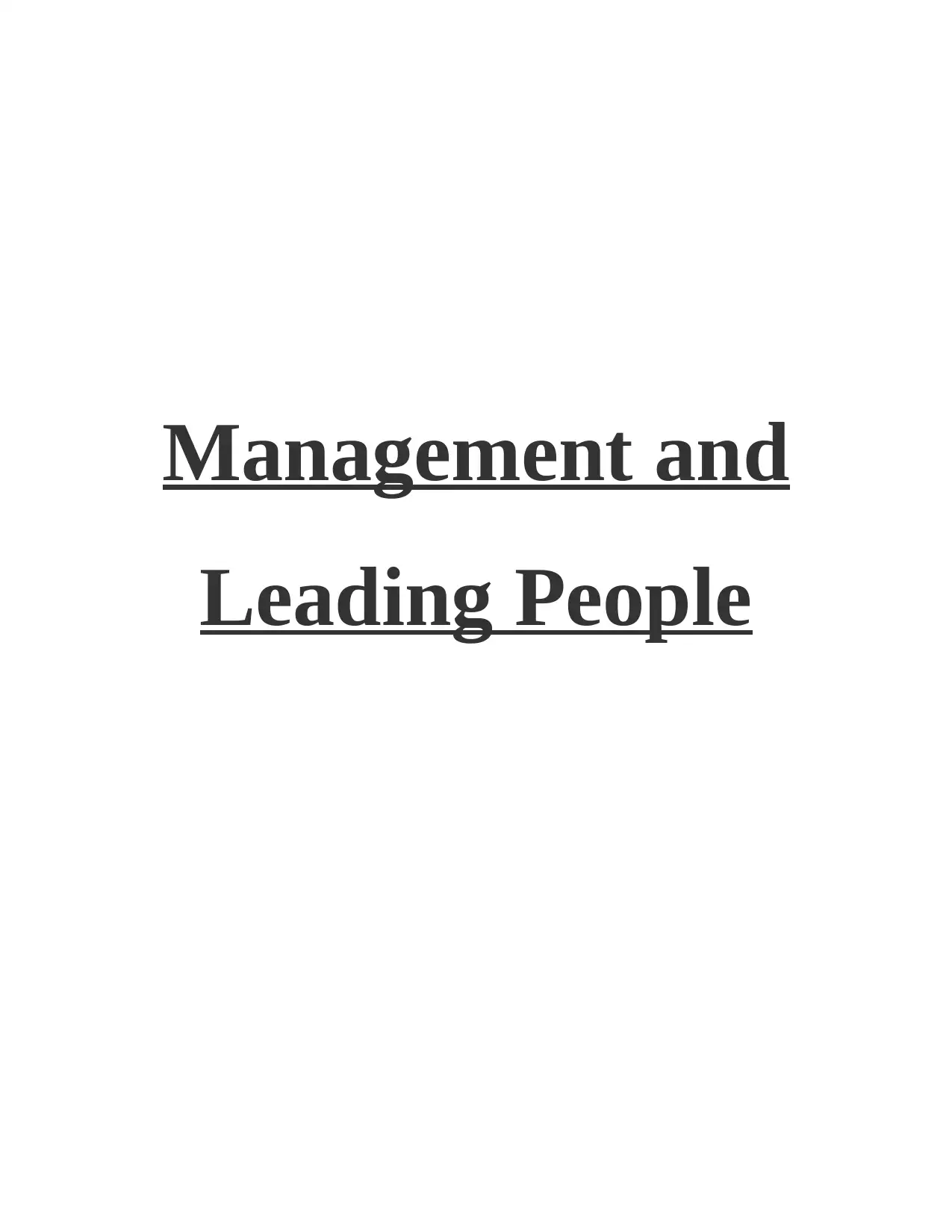
Management and
Leading People
Leading People
Paraphrase This Document
Need a fresh take? Get an instant paraphrase of this document with our AI Paraphraser
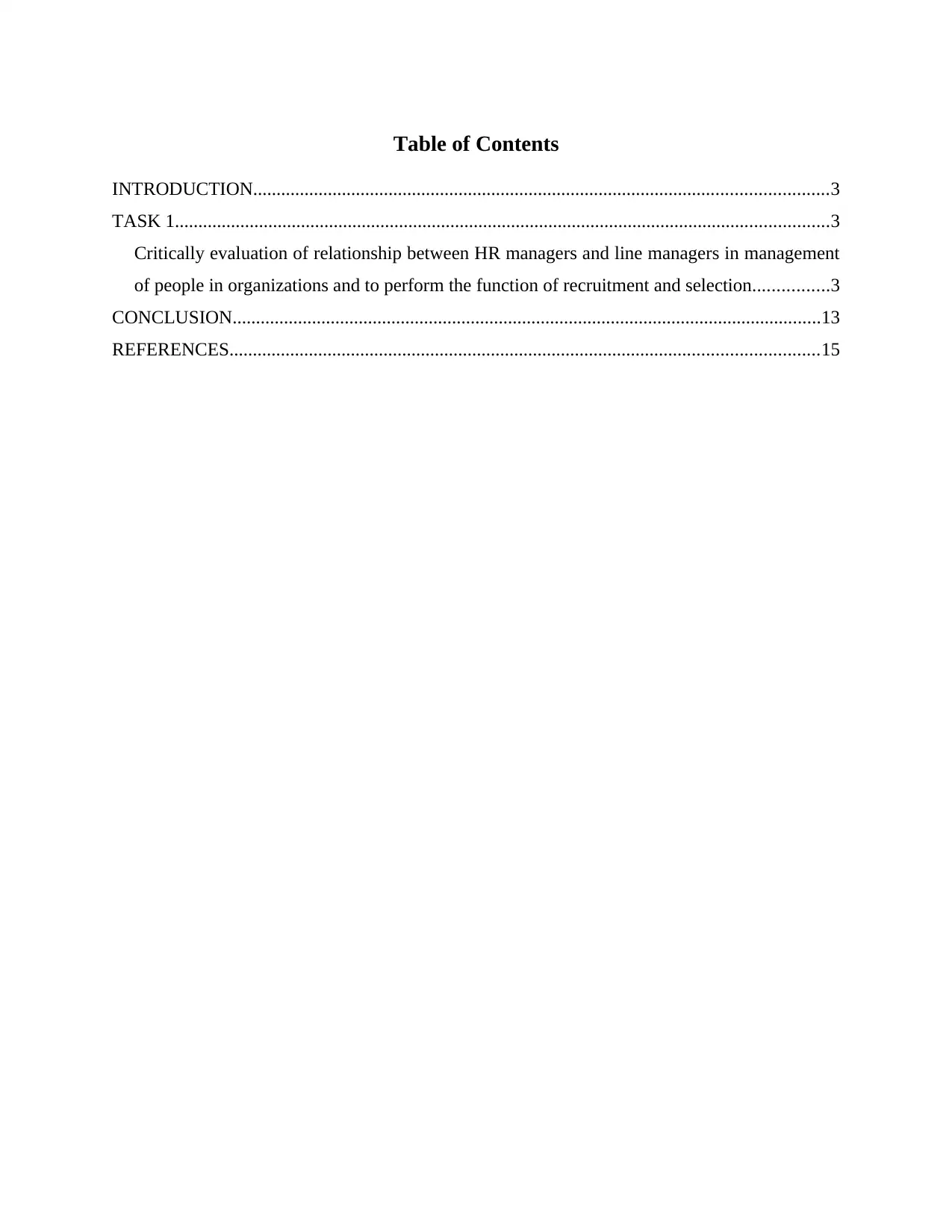
Table of Contents
INTRODUCTION...........................................................................................................................3
TASK 1............................................................................................................................................3
Critically evaluation of relationship between HR managers and line managers in management
of people in organizations and to perform the function of recruitment and selection................3
CONCLUSION..............................................................................................................................13
REFERENCES..............................................................................................................................15
INTRODUCTION...........................................................................................................................3
TASK 1............................................................................................................................................3
Critically evaluation of relationship between HR managers and line managers in management
of people in organizations and to perform the function of recruitment and selection................3
CONCLUSION..............................................................................................................................13
REFERENCES..............................................................................................................................15
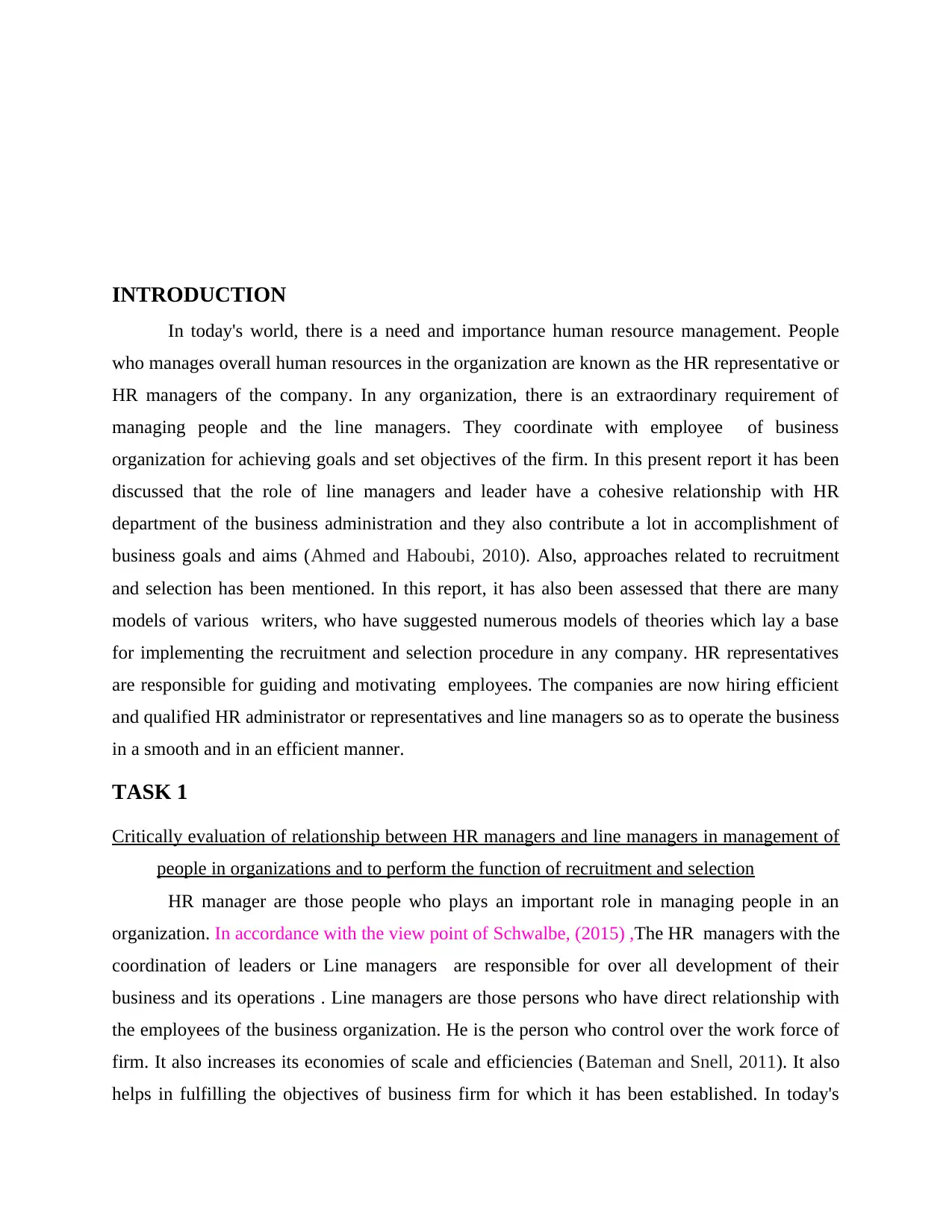
INTRODUCTION
In today's world, there is a need and importance human resource management. People
who manages overall human resources in the organization are known as the HR representative or
HR managers of the company. In any organization, there is an extraordinary requirement of
managing people and the line managers. They coordinate with employee of business
organization for achieving goals and set objectives of the firm. In this present report it has been
discussed that the role of line managers and leader have a cohesive relationship with HR
department of the business administration and they also contribute a lot in accomplishment of
business goals and aims (Ahmed and Haboubi, 2010). Also, approaches related to recruitment
and selection has been mentioned. In this report, it has also been assessed that there are many
models of various writers, who have suggested numerous models of theories which lay a base
for implementing the recruitment and selection procedure in any company. HR representatives
are responsible for guiding and motivating employees. The companies are now hiring efficient
and qualified HR administrator or representatives and line managers so as to operate the business
in a smooth and in an efficient manner.
TASK 1
Critically evaluation of relationship between HR managers and line managers in management of
people in organizations and to perform the function of recruitment and selection
HR manager are those people who plays an important role in managing people in an
organization. In accordance with the view point of Schwalbe, (2015) ,The HR managers with the
coordination of leaders or Line managers are responsible for over all development of their
business and its operations . Line managers are those persons who have direct relationship with
the employees of the business organization. He is the person who control over the work force of
firm. It also increases its economies of scale and efficiencies (Bateman and Snell, 2011). It also
helps in fulfilling the objectives of business firm for which it has been established. In today's
In today's world, there is a need and importance human resource management. People
who manages overall human resources in the organization are known as the HR representative or
HR managers of the company. In any organization, there is an extraordinary requirement of
managing people and the line managers. They coordinate with employee of business
organization for achieving goals and set objectives of the firm. In this present report it has been
discussed that the role of line managers and leader have a cohesive relationship with HR
department of the business administration and they also contribute a lot in accomplishment of
business goals and aims (Ahmed and Haboubi, 2010). Also, approaches related to recruitment
and selection has been mentioned. In this report, it has also been assessed that there are many
models of various writers, who have suggested numerous models of theories which lay a base
for implementing the recruitment and selection procedure in any company. HR representatives
are responsible for guiding and motivating employees. The companies are now hiring efficient
and qualified HR administrator or representatives and line managers so as to operate the business
in a smooth and in an efficient manner.
TASK 1
Critically evaluation of relationship between HR managers and line managers in management of
people in organizations and to perform the function of recruitment and selection
HR manager are those people who plays an important role in managing people in an
organization. In accordance with the view point of Schwalbe, (2015) ,The HR managers with the
coordination of leaders or Line managers are responsible for over all development of their
business and its operations . Line managers are those persons who have direct relationship with
the employees of the business organization. He is the person who control over the work force of
firm. It also increases its economies of scale and efficiencies (Bateman and Snell, 2011). It also
helps in fulfilling the objectives of business firm for which it has been established. In today's
⊘ This is a preview!⊘
Do you want full access?
Subscribe today to unlock all pages.

Trusted by 1+ million students worldwide

world era, it can be analysed that there is a trend of competitiveness in the market area or
industry. Chhokar, Brodbeck and House (2013) says that the companies try to be at number one
and also to gain competitive advantage over its rival business firms. This can be only possible
through effective management of employees and work force of the company. It should be noted
that employees are key to success of any business institution. They are liable for doing the tasks
and performing their duties which have been assigned to them by HR managers and leaders of
their company. Line managers play an essential function in the human resources management.
They coordinate with HR managers of the organization and support in many ways like
filling out firms of appraisal, candidates interviews for filling the vacant post in firm, increasing
the salary and benefits and also gives employment related news to its employees. On the other
hand, Berger, (2011) says that HR is a person or an individual which has the capacity to
influence or impact its members in team , results or outcomes of HR and also the
conceptualisation of HR (William P, 2010).
Likewise any other department, HR manger also has two basic functions that are mainly
related to overseeing sector function and direction of employees.
The specific role of HR managers in the context of organizations is as:
HR manager have complete responsibilities related to strategic and functional
responsibilities of the business operations. A HR manger has its expertise as the HR
scholar person and also he is skilled with the business and management skills and
abilities so as to conduct business operations in a smooth manner.
HR managers are accountable for providing proper guidance and direction to its
employees. Further, they are also responsible in providing accurate and appropriate
compensations and benefits. HR mangers develop important compensation plans and
adjust performance management system with compensation and benefit structure along
with this, they also monitor the performance of their work force.
Training and development is one of the most important functions of HR representatives.
Worker grooming and improvement includes new hire induction, leadership training and
professional development seminars and sessions which enhances and increase the skills
and abilities of employees that will contribute to overall development of the company..
They assess the requirement as whether is it necessary for their firm to conduct training
and development workforce for the new hired applicants.
industry. Chhokar, Brodbeck and House (2013) says that the companies try to be at number one
and also to gain competitive advantage over its rival business firms. This can be only possible
through effective management of employees and work force of the company. It should be noted
that employees are key to success of any business institution. They are liable for doing the tasks
and performing their duties which have been assigned to them by HR managers and leaders of
their company. Line managers play an essential function in the human resources management.
They coordinate with HR managers of the organization and support in many ways like
filling out firms of appraisal, candidates interviews for filling the vacant post in firm, increasing
the salary and benefits and also gives employment related news to its employees. On the other
hand, Berger, (2011) says that HR is a person or an individual which has the capacity to
influence or impact its members in team , results or outcomes of HR and also the
conceptualisation of HR (William P, 2010).
Likewise any other department, HR manger also has two basic functions that are mainly
related to overseeing sector function and direction of employees.
The specific role of HR managers in the context of organizations is as:
HR manager have complete responsibilities related to strategic and functional
responsibilities of the business operations. A HR manger has its expertise as the HR
scholar person and also he is skilled with the business and management skills and
abilities so as to conduct business operations in a smooth manner.
HR managers are accountable for providing proper guidance and direction to its
employees. Further, they are also responsible in providing accurate and appropriate
compensations and benefits. HR mangers develop important compensation plans and
adjust performance management system with compensation and benefit structure along
with this, they also monitor the performance of their work force.
Training and development is one of the most important functions of HR representatives.
Worker grooming and improvement includes new hire induction, leadership training and
professional development seminars and sessions which enhances and increase the skills
and abilities of employees that will contribute to overall development of the company..
They assess the requirement as whether is it necessary for their firm to conduct training
and development workforce for the new hired applicants.
Paraphrase This Document
Need a fresh take? Get an instant paraphrase of this document with our AI Paraphraser
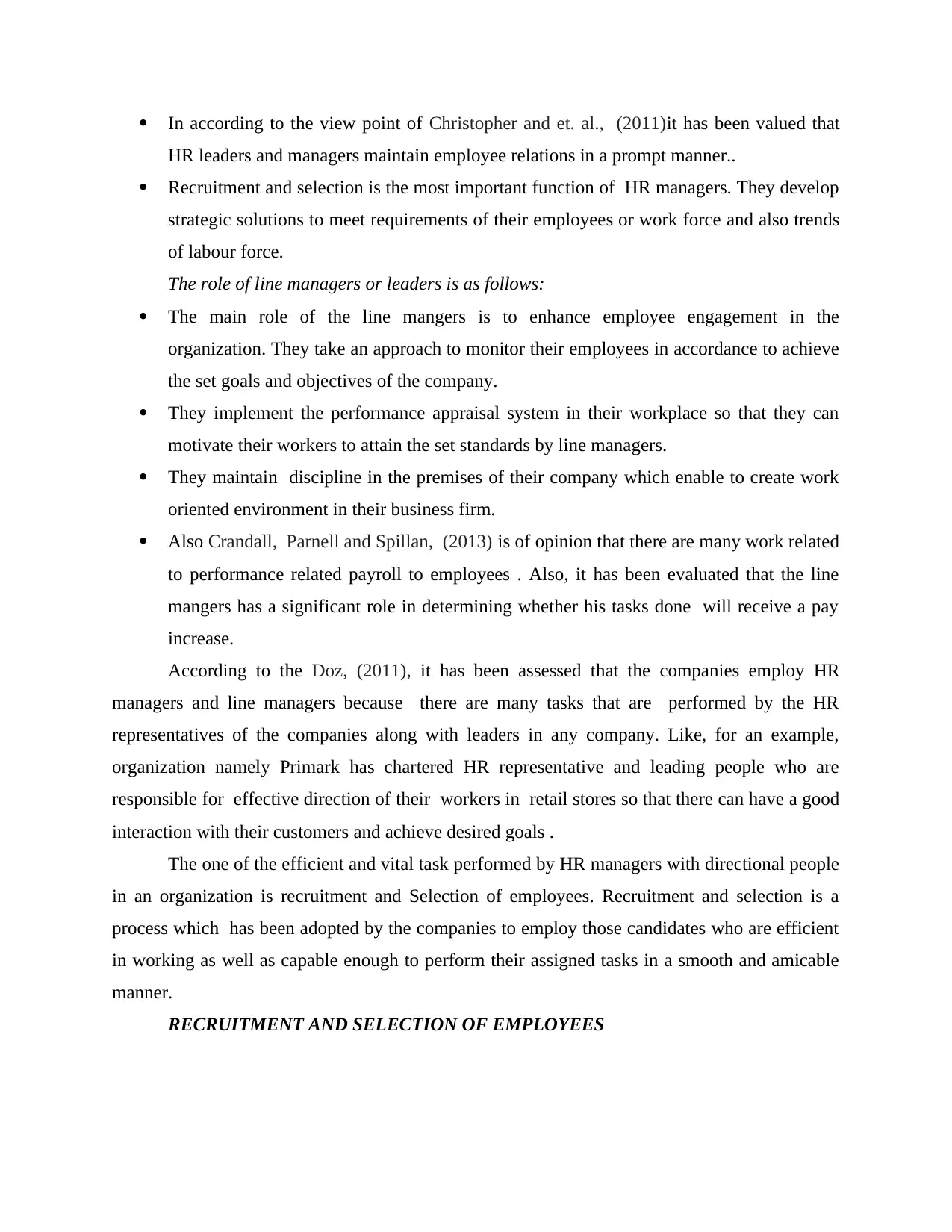
In according to the view point of Christopher and et. al., (2011)it has been valued that
HR leaders and managers maintain employee relations in a prompt manner..
Recruitment and selection is the most important function of HR managers. They develop
strategic solutions to meet requirements of their employees or work force and also trends
of labour force.
The role of line managers or leaders is as follows:
The main role of the line mangers is to enhance employee engagement in the
organization. They take an approach to monitor their employees in accordance to achieve
the set goals and objectives of the company.
They implement the performance appraisal system in their workplace so that they can
motivate their workers to attain the set standards by line managers.
They maintain discipline in the premises of their company which enable to create work
oriented environment in their business firm.
Also Crandall, Parnell and Spillan, (2013) is of opinion that there are many work related
to performance related payroll to employees . Also, it has been evaluated that the line
mangers has a significant role in determining whether his tasks done will receive a pay
increase.
According to the Doz, (2011), it has been assessed that the companies employ HR
managers and line managers because there are many tasks that are performed by the HR
representatives of the companies along with leaders in any company. Like, for an example,
organization namely Primark has chartered HR representative and leading people who are
responsible for effective direction of their workers in retail stores so that there can have a good
interaction with their customers and achieve desired goals .
The one of the efficient and vital task performed by HR managers with directional people
in an organization is recruitment and Selection of employees. Recruitment and selection is a
process which has been adopted by the companies to employ those candidates who are efficient
in working as well as capable enough to perform their assigned tasks in a smooth and amicable
manner.
RECRUITMENT AND SELECTION OF EMPLOYEES
HR leaders and managers maintain employee relations in a prompt manner..
Recruitment and selection is the most important function of HR managers. They develop
strategic solutions to meet requirements of their employees or work force and also trends
of labour force.
The role of line managers or leaders is as follows:
The main role of the line mangers is to enhance employee engagement in the
organization. They take an approach to monitor their employees in accordance to achieve
the set goals and objectives of the company.
They implement the performance appraisal system in their workplace so that they can
motivate their workers to attain the set standards by line managers.
They maintain discipline in the premises of their company which enable to create work
oriented environment in their business firm.
Also Crandall, Parnell and Spillan, (2013) is of opinion that there are many work related
to performance related payroll to employees . Also, it has been evaluated that the line
mangers has a significant role in determining whether his tasks done will receive a pay
increase.
According to the Doz, (2011), it has been assessed that the companies employ HR
managers and line managers because there are many tasks that are performed by the HR
representatives of the companies along with leaders in any company. Like, for an example,
organization namely Primark has chartered HR representative and leading people who are
responsible for effective direction of their workers in retail stores so that there can have a good
interaction with their customers and achieve desired goals .
The one of the efficient and vital task performed by HR managers with directional people
in an organization is recruitment and Selection of employees. Recruitment and selection is a
process which has been adopted by the companies to employ those candidates who are efficient
in working as well as capable enough to perform their assigned tasks in a smooth and amicable
manner.
RECRUITMENT AND SELECTION OF EMPLOYEES
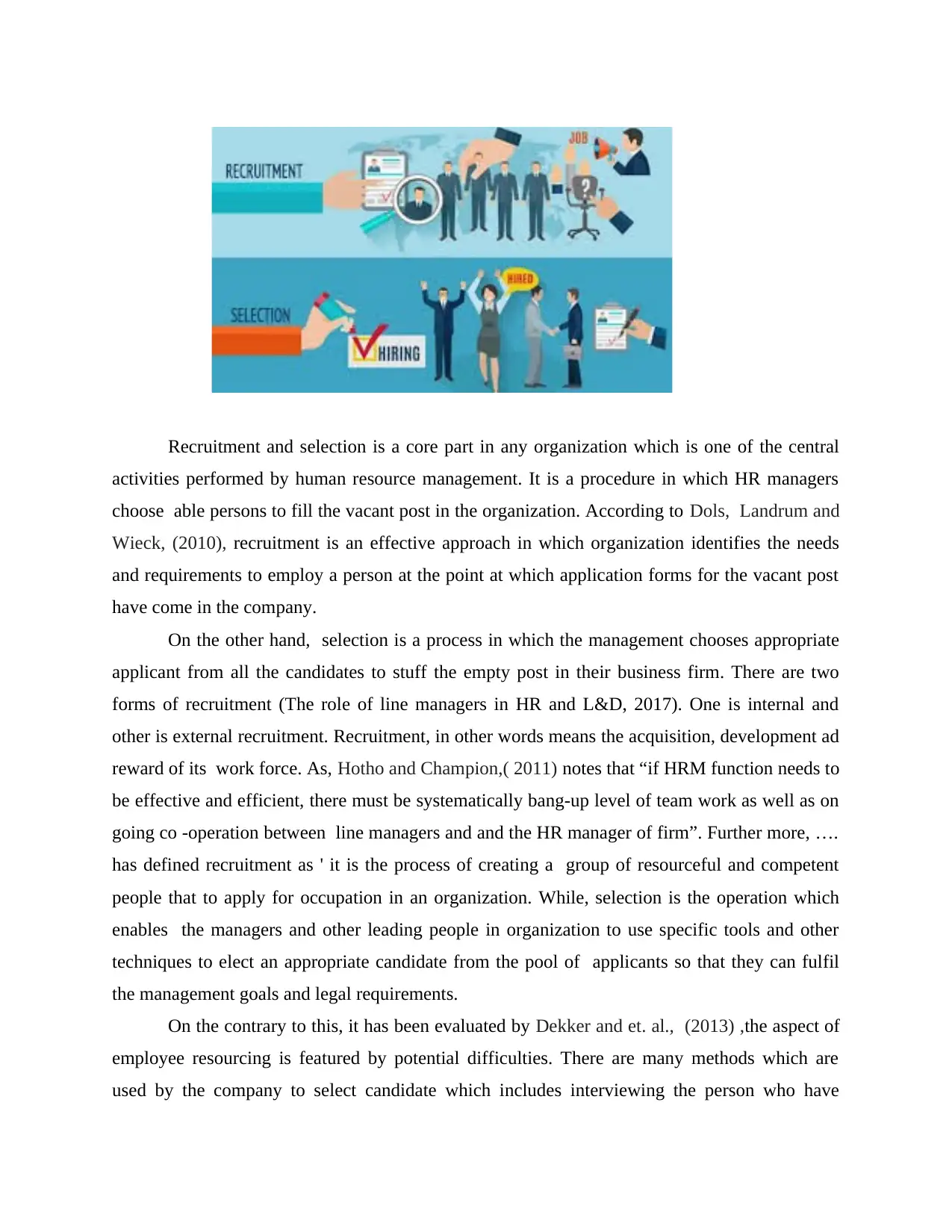
Recruitment and selection is a core part in any organization which is one of the central
activities performed by human resource management. It is a procedure in which HR managers
choose able persons to fill the vacant post in the organization. According to Dols, Landrum and
Wieck, (2010), recruitment is an effective approach in which organization identifies the needs
and requirements to employ a person at the point at which application forms for the vacant post
have come in the company.
On the other hand, selection is a process in which the management chooses appropriate
applicant from all the candidates to stuff the empty post in their business firm. There are two
forms of recruitment (The role of line managers in HR and L&D, 2017). One is internal and
other is external recruitment. Recruitment, in other words means the acquisition, development ad
reward of its work force. As, Hotho and Champion,( 2011) notes that “if HRM function needs to
be effective and efficient, there must be systematically bang-up level of team work as well as on
going co -operation between line managers and and the HR manager of firm”. Further more, ….
has defined recruitment as ' it is the process of creating a group of resourceful and competent
people that to apply for occupation in an organization. While, selection is the operation which
enables the managers and other leading people in organization to use specific tools and other
techniques to elect an appropriate candidate from the pool of applicants so that they can fulfil
the management goals and legal requirements.
On the contrary to this, it has been evaluated by Dekker and et. al., (2013) ,the aspect of
employee resourcing is featured by potential difficulties. There are many methods which are
used by the company to select candidate which includes interviewing the person who have
activities performed by human resource management. It is a procedure in which HR managers
choose able persons to fill the vacant post in the organization. According to Dols, Landrum and
Wieck, (2010), recruitment is an effective approach in which organization identifies the needs
and requirements to employ a person at the point at which application forms for the vacant post
have come in the company.
On the other hand, selection is a process in which the management chooses appropriate
applicant from all the candidates to stuff the empty post in their business firm. There are two
forms of recruitment (The role of line managers in HR and L&D, 2017). One is internal and
other is external recruitment. Recruitment, in other words means the acquisition, development ad
reward of its work force. As, Hotho and Champion,( 2011) notes that “if HRM function needs to
be effective and efficient, there must be systematically bang-up level of team work as well as on
going co -operation between line managers and and the HR manager of firm”. Further more, ….
has defined recruitment as ' it is the process of creating a group of resourceful and competent
people that to apply for occupation in an organization. While, selection is the operation which
enables the managers and other leading people in organization to use specific tools and other
techniques to elect an appropriate candidate from the pool of applicants so that they can fulfil
the management goals and legal requirements.
On the contrary to this, it has been evaluated by Dekker and et. al., (2013) ,the aspect of
employee resourcing is featured by potential difficulties. There are many methods which are
used by the company to select candidate which includes interviewing the person who have
⊘ This is a preview!⊘
Do you want full access?
Subscribe today to unlock all pages.

Trusted by 1+ million students worldwide
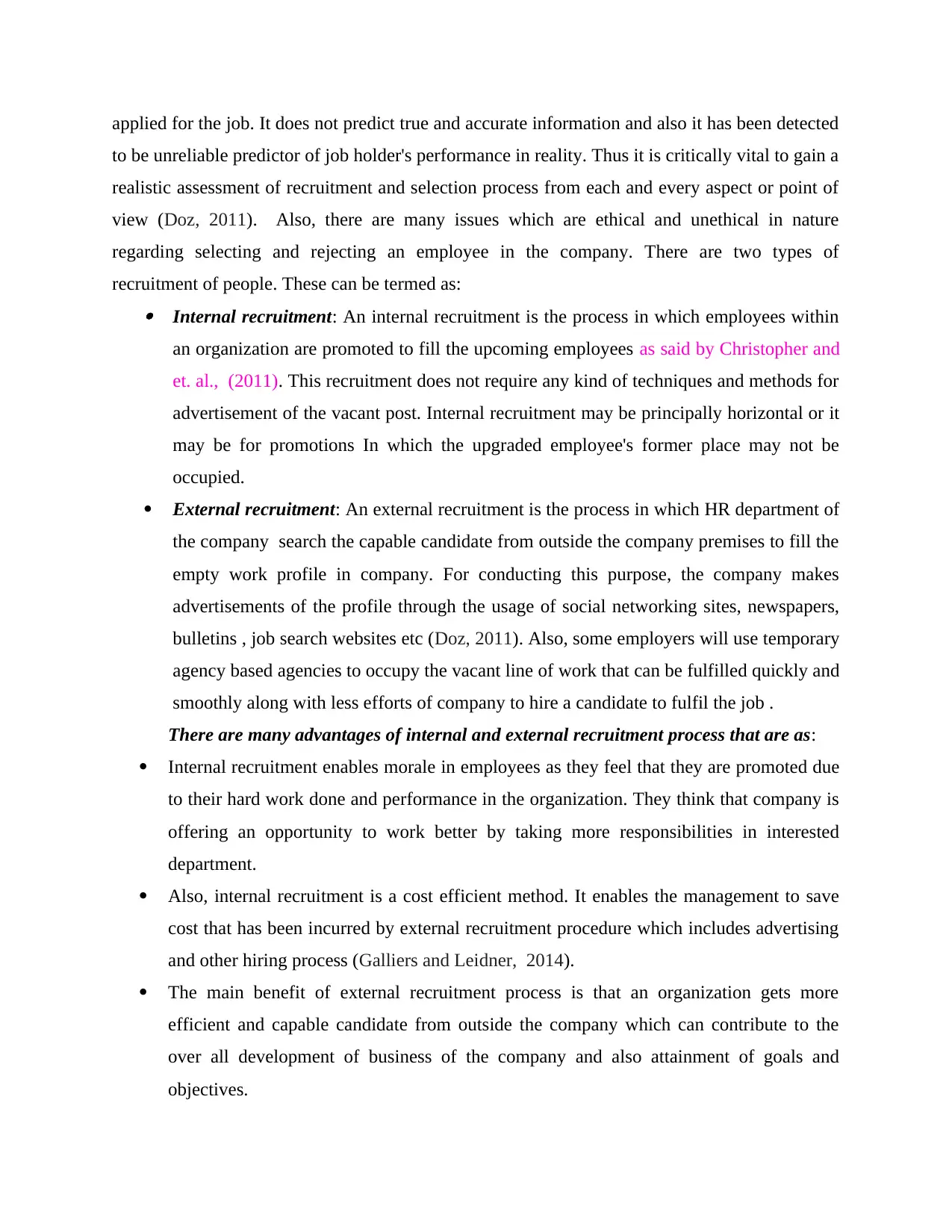
applied for the job. It does not predict true and accurate information and also it has been detected
to be unreliable predictor of job holder's performance in reality. Thus it is critically vital to gain a
realistic assessment of recruitment and selection process from each and every aspect or point of
view (Doz, 2011). Also, there are many issues which are ethical and unethical in nature
regarding selecting and rejecting an employee in the company. There are two types of
recruitment of people. These can be termed as: Internal recruitment: An internal recruitment is the process in which employees within
an organization are promoted to fill the upcoming employees as said by Christopher and
et. al., (2011). This recruitment does not require any kind of techniques and methods for
advertisement of the vacant post. Internal recruitment may be principally horizontal or it
may be for promotions In which the upgraded employee's former place may not be
occupied.
External recruitment: An external recruitment is the process in which HR department of
the company search the capable candidate from outside the company premises to fill the
empty work profile in company. For conducting this purpose, the company makes
advertisements of the profile through the usage of social networking sites, newspapers,
bulletins , job search websites etc (Doz, 2011). Also, some employers will use temporary
agency based agencies to occupy the vacant line of work that can be fulfilled quickly and
smoothly along with less efforts of company to hire a candidate to fulfil the job .
There are many advantages of internal and external recruitment process that are as:
Internal recruitment enables morale in employees as they feel that they are promoted due
to their hard work done and performance in the organization. They think that company is
offering an opportunity to work better by taking more responsibilities in interested
department.
Also, internal recruitment is a cost efficient method. It enables the management to save
cost that has been incurred by external recruitment procedure which includes advertising
and other hiring process (Galliers and Leidner, 2014).
The main benefit of external recruitment process is that an organization gets more
efficient and capable candidate from outside the company which can contribute to the
over all development of business of the company and also attainment of goals and
objectives.
to be unreliable predictor of job holder's performance in reality. Thus it is critically vital to gain a
realistic assessment of recruitment and selection process from each and every aspect or point of
view (Doz, 2011). Also, there are many issues which are ethical and unethical in nature
regarding selecting and rejecting an employee in the company. There are two types of
recruitment of people. These can be termed as: Internal recruitment: An internal recruitment is the process in which employees within
an organization are promoted to fill the upcoming employees as said by Christopher and
et. al., (2011). This recruitment does not require any kind of techniques and methods for
advertisement of the vacant post. Internal recruitment may be principally horizontal or it
may be for promotions In which the upgraded employee's former place may not be
occupied.
External recruitment: An external recruitment is the process in which HR department of
the company search the capable candidate from outside the company premises to fill the
empty work profile in company. For conducting this purpose, the company makes
advertisements of the profile through the usage of social networking sites, newspapers,
bulletins , job search websites etc (Doz, 2011). Also, some employers will use temporary
agency based agencies to occupy the vacant line of work that can be fulfilled quickly and
smoothly along with less efforts of company to hire a candidate to fulfil the job .
There are many advantages of internal and external recruitment process that are as:
Internal recruitment enables morale in employees as they feel that they are promoted due
to their hard work done and performance in the organization. They think that company is
offering an opportunity to work better by taking more responsibilities in interested
department.
Also, internal recruitment is a cost efficient method. It enables the management to save
cost that has been incurred by external recruitment procedure which includes advertising
and other hiring process (Galliers and Leidner, 2014).
The main benefit of external recruitment process is that an organization gets more
efficient and capable candidate from outside the company which can contribute to the
over all development of business of the company and also attainment of goals and
objectives.
Paraphrase This Document
Need a fresh take? Get an instant paraphrase of this document with our AI Paraphraser
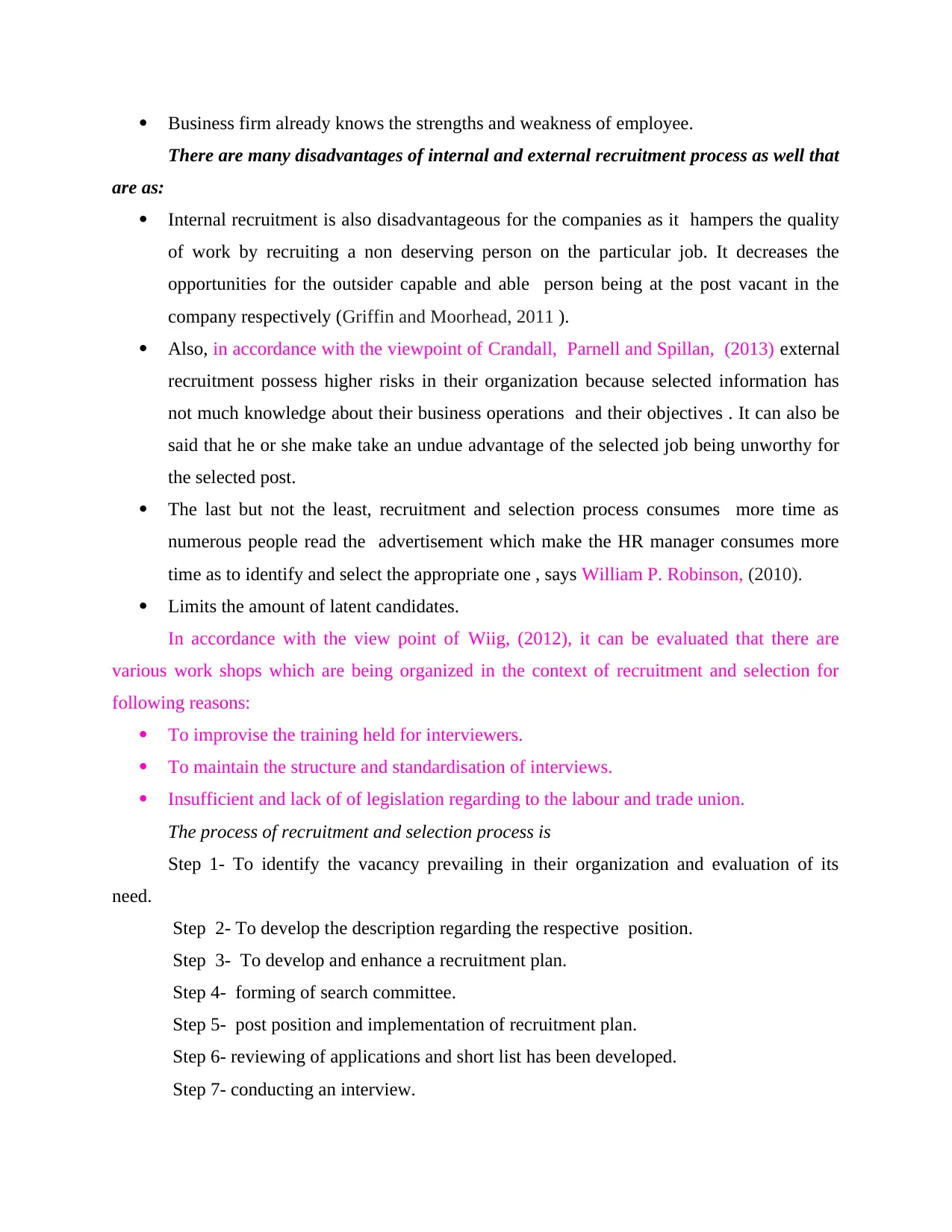
Business firm already knows the strengths and weakness of employee.
There are many disadvantages of internal and external recruitment process as well that
are as:
Internal recruitment is also disadvantageous for the companies as it hampers the quality
of work by recruiting a non deserving person on the particular job. It decreases the
opportunities for the outsider capable and able person being at the post vacant in the
company respectively (Griffin and Moorhead, 2011 ).
Also, in accordance with the viewpoint of Crandall, Parnell and Spillan, (2013) external
recruitment possess higher risks in their organization because selected information has
not much knowledge about their business operations and their objectives . It can also be
said that he or she make take an undue advantage of the selected job being unworthy for
the selected post.
The last but not the least, recruitment and selection process consumes more time as
numerous people read the advertisement which make the HR manager consumes more
time as to identify and select the appropriate one , says William P. Robinson, (2010).
Limits the amount of latent candidates.
In accordance with the view point of Wiig, (2012), it can be evaluated that there are
various work shops which are being organized in the context of recruitment and selection for
following reasons:
To improvise the training held for interviewers.
To maintain the structure and standardisation of interviews.
Insufficient and lack of of legislation regarding to the labour and trade union.
The process of recruitment and selection process is
Step 1- To identify the vacancy prevailing in their organization and evaluation of its
need.
Step 2- To develop the description regarding the respective position.
Step 3- To develop and enhance a recruitment plan.
Step 4- forming of search committee.
Step 5- post position and implementation of recruitment plan.
Step 6- reviewing of applications and short list has been developed.
Step 7- conducting an interview.
There are many disadvantages of internal and external recruitment process as well that
are as:
Internal recruitment is also disadvantageous for the companies as it hampers the quality
of work by recruiting a non deserving person on the particular job. It decreases the
opportunities for the outsider capable and able person being at the post vacant in the
company respectively (Griffin and Moorhead, 2011 ).
Also, in accordance with the viewpoint of Crandall, Parnell and Spillan, (2013) external
recruitment possess higher risks in their organization because selected information has
not much knowledge about their business operations and their objectives . It can also be
said that he or she make take an undue advantage of the selected job being unworthy for
the selected post.
The last but not the least, recruitment and selection process consumes more time as
numerous people read the advertisement which make the HR manager consumes more
time as to identify and select the appropriate one , says William P. Robinson, (2010).
Limits the amount of latent candidates.
In accordance with the view point of Wiig, (2012), it can be evaluated that there are
various work shops which are being organized in the context of recruitment and selection for
following reasons:
To improvise the training held for interviewers.
To maintain the structure and standardisation of interviews.
Insufficient and lack of of legislation regarding to the labour and trade union.
The process of recruitment and selection process is
Step 1- To identify the vacancy prevailing in their organization and evaluation of its
need.
Step 2- To develop the description regarding the respective position.
Step 3- To develop and enhance a recruitment plan.
Step 4- forming of search committee.
Step 5- post position and implementation of recruitment plan.
Step 6- reviewing of applications and short list has been developed.
Step 7- conducting an interview.
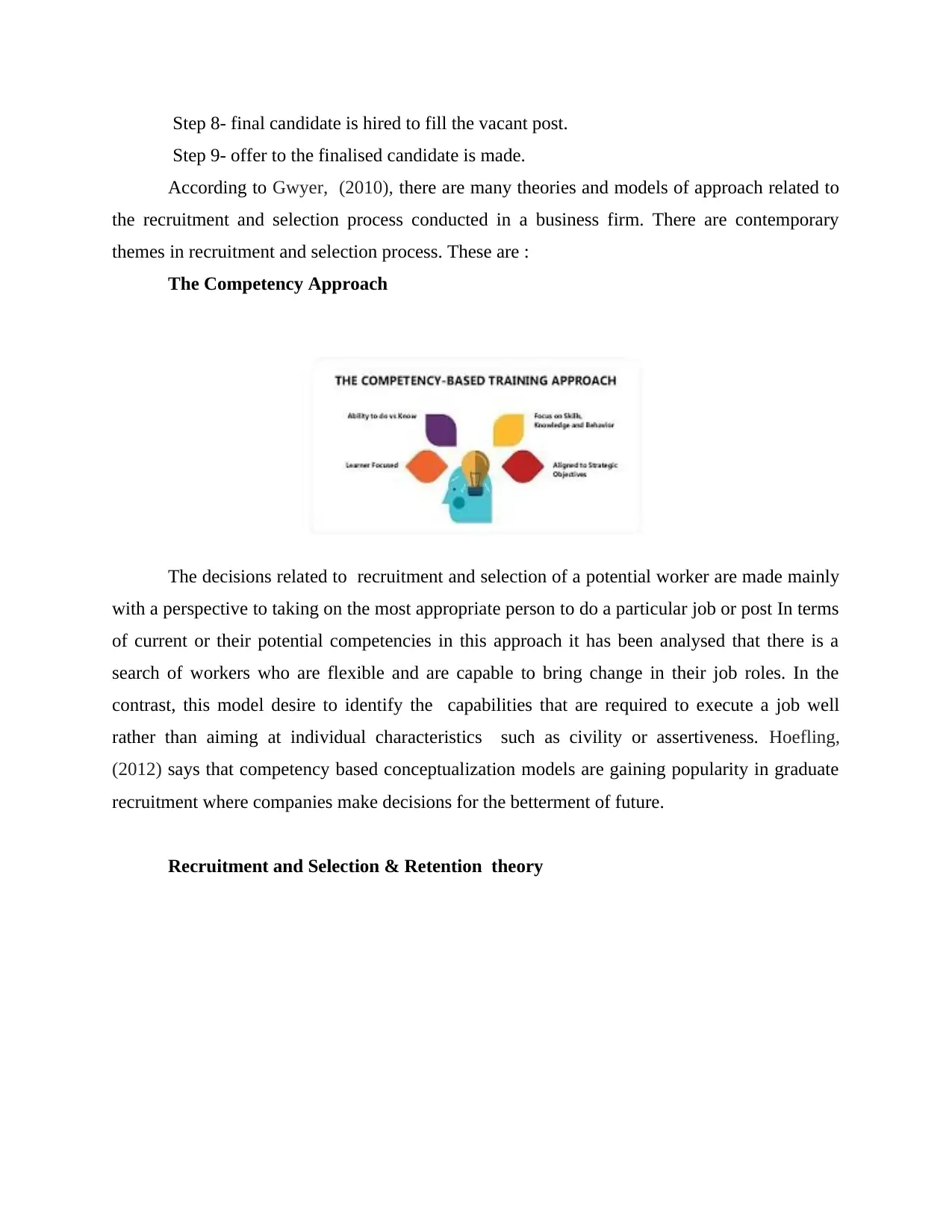
Step 8- final candidate is hired to fill the vacant post.
Step 9- offer to the finalised candidate is made.
According to Gwyer, (2010), there are many theories and models of approach related to
the recruitment and selection process conducted in a business firm. There are contemporary
themes in recruitment and selection process. These are :
The Competency Approach
The decisions related to recruitment and selection of a potential worker are made mainly
with a perspective to taking on the most appropriate person to do a particular job or post In terms
of current or their potential competencies in this approach it has been analysed that there is a
search of workers who are flexible and are capable to bring change in their job roles. In the
contrast, this model desire to identify the capabilities that are required to execute a job well
rather than aiming at individual characteristics such as civility or assertiveness. Hoefling,
(2012) says that competency based conceptualization models are gaining popularity in graduate
recruitment where companies make decisions for the betterment of future.
Recruitment and Selection & Retention theory
Step 9- offer to the finalised candidate is made.
According to Gwyer, (2010), there are many theories and models of approach related to
the recruitment and selection process conducted in a business firm. There are contemporary
themes in recruitment and selection process. These are :
The Competency Approach
The decisions related to recruitment and selection of a potential worker are made mainly
with a perspective to taking on the most appropriate person to do a particular job or post In terms
of current or their potential competencies in this approach it has been analysed that there is a
search of workers who are flexible and are capable to bring change in their job roles. In the
contrast, this model desire to identify the capabilities that are required to execute a job well
rather than aiming at individual characteristics such as civility or assertiveness. Hoefling,
(2012) says that competency based conceptualization models are gaining popularity in graduate
recruitment where companies make decisions for the betterment of future.
Recruitment and Selection & Retention theory
⊘ This is a preview!⊘
Do you want full access?
Subscribe today to unlock all pages.

Trusted by 1+ million students worldwide
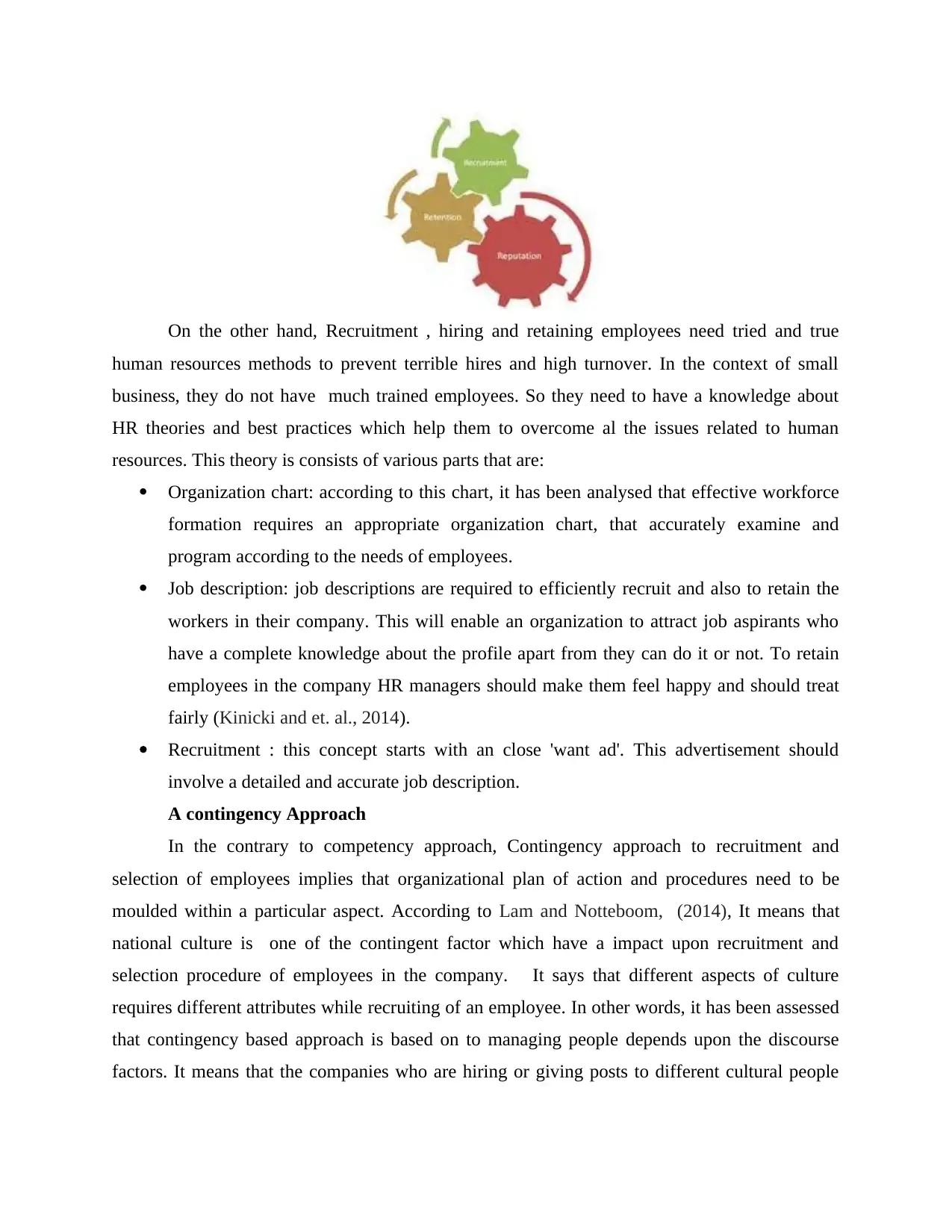
On the other hand, Recruitment , hiring and retaining employees need tried and true
human resources methods to prevent terrible hires and high turnover. In the context of small
business, they do not have much trained employees. So they need to have a knowledge about
HR theories and best practices which help them to overcome al the issues related to human
resources. This theory is consists of various parts that are:
Organization chart: according to this chart, it has been analysed that effective workforce
formation requires an appropriate organization chart, that accurately examine and
program according to the needs of employees.
Job description: job descriptions are required to efficiently recruit and also to retain the
workers in their company. This will enable an organization to attract job aspirants who
have a complete knowledge about the profile apart from they can do it or not. To retain
employees in the company HR managers should make them feel happy and should treat
fairly (Kinicki and et. al., 2014).
Recruitment : this concept starts with an close 'want ad'. This advertisement should
involve a detailed and accurate job description.
A contingency Approach
In the contrary to competency approach, Contingency approach to recruitment and
selection of employees implies that organizational plan of action and procedures need to be
moulded within a particular aspect. According to Lam and Notteboom, (2014), It means that
national culture is one of the contingent factor which have a impact upon recruitment and
selection procedure of employees in the company. It says that different aspects of culture
requires different attributes while recruiting of an employee. In other words, it has been assessed
that contingency based approach is based on to managing people depends upon the discourse
factors. It means that the companies who are hiring or giving posts to different cultural people
human resources methods to prevent terrible hires and high turnover. In the context of small
business, they do not have much trained employees. So they need to have a knowledge about
HR theories and best practices which help them to overcome al the issues related to human
resources. This theory is consists of various parts that are:
Organization chart: according to this chart, it has been analysed that effective workforce
formation requires an appropriate organization chart, that accurately examine and
program according to the needs of employees.
Job description: job descriptions are required to efficiently recruit and also to retain the
workers in their company. This will enable an organization to attract job aspirants who
have a complete knowledge about the profile apart from they can do it or not. To retain
employees in the company HR managers should make them feel happy and should treat
fairly (Kinicki and et. al., 2014).
Recruitment : this concept starts with an close 'want ad'. This advertisement should
involve a detailed and accurate job description.
A contingency Approach
In the contrary to competency approach, Contingency approach to recruitment and
selection of employees implies that organizational plan of action and procedures need to be
moulded within a particular aspect. According to Lam and Notteboom, (2014), It means that
national culture is one of the contingent factor which have a impact upon recruitment and
selection procedure of employees in the company. It says that different aspects of culture
requires different attributes while recruiting of an employee. In other words, it has been assessed
that contingency based approach is based on to managing people depends upon the discourse
factors. It means that the companies who are hiring or giving posts to different cultural people
Paraphrase This Document
Need a fresh take? Get an instant paraphrase of this document with our AI Paraphraser
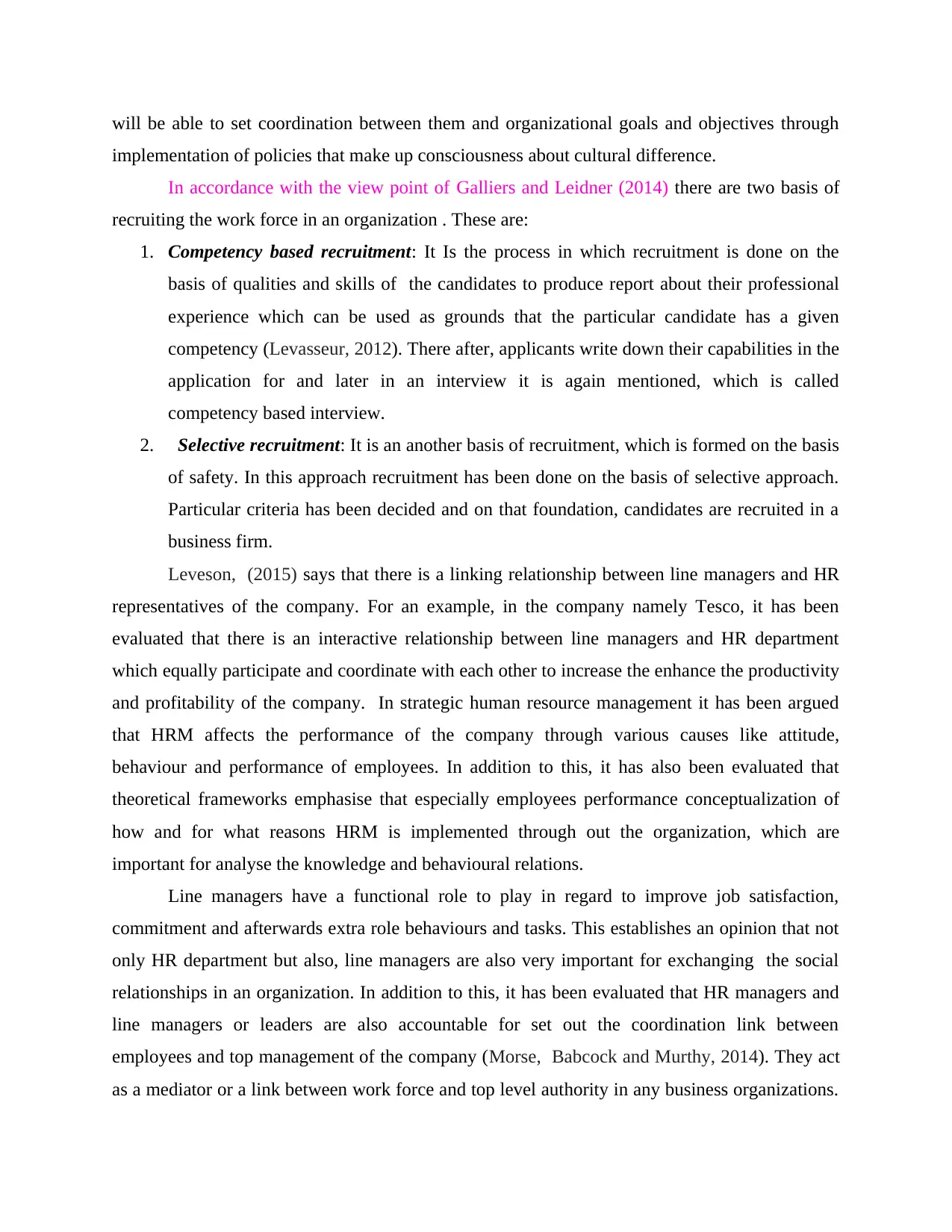
will be able to set coordination between them and organizational goals and objectives through
implementation of policies that make up consciousness about cultural difference.
In accordance with the view point of Galliers and Leidner (2014) there are two basis of
recruiting the work force in an organization . These are:
1. Competency based recruitment: It Is the process in which recruitment is done on the
basis of qualities and skills of the candidates to produce report about their professional
experience which can be used as grounds that the particular candidate has a given
competency (Levasseur, 2012). There after, applicants write down their capabilities in the
application for and later in an interview it is again mentioned, which is called
competency based interview.
2. Selective recruitment: It is an another basis of recruitment, which is formed on the basis
of safety. In this approach recruitment has been done on the basis of selective approach.
Particular criteria has been decided and on that foundation, candidates are recruited in a
business firm.
Leveson, (2015) says that there is a linking relationship between line managers and HR
representatives of the company. For an example, in the company namely Tesco, it has been
evaluated that there is an interactive relationship between line managers and HR department
which equally participate and coordinate with each other to increase the enhance the productivity
and profitability of the company. In strategic human resource management it has been argued
that HRM affects the performance of the company through various causes like attitude,
behaviour and performance of employees. In addition to this, it has also been evaluated that
theoretical frameworks emphasise that especially employees performance conceptualization of
how and for what reasons HRM is implemented through out the organization, which are
important for analyse the knowledge and behavioural relations.
Line managers have a functional role to play in regard to improve job satisfaction,
commitment and afterwards extra role behaviours and tasks. This establishes an opinion that not
only HR department but also, line managers are also very important for exchanging the social
relationships in an organization. In addition to this, it has been evaluated that HR managers and
line managers or leaders are also accountable for set out the coordination link between
employees and top management of the company (Morse, Babcock and Murthy, 2014). They act
as a mediator or a link between work force and top level authority in any business organizations.
implementation of policies that make up consciousness about cultural difference.
In accordance with the view point of Galliers and Leidner (2014) there are two basis of
recruiting the work force in an organization . These are:
1. Competency based recruitment: It Is the process in which recruitment is done on the
basis of qualities and skills of the candidates to produce report about their professional
experience which can be used as grounds that the particular candidate has a given
competency (Levasseur, 2012). There after, applicants write down their capabilities in the
application for and later in an interview it is again mentioned, which is called
competency based interview.
2. Selective recruitment: It is an another basis of recruitment, which is formed on the basis
of safety. In this approach recruitment has been done on the basis of selective approach.
Particular criteria has been decided and on that foundation, candidates are recruited in a
business firm.
Leveson, (2015) says that there is a linking relationship between line managers and HR
representatives of the company. For an example, in the company namely Tesco, it has been
evaluated that there is an interactive relationship between line managers and HR department
which equally participate and coordinate with each other to increase the enhance the productivity
and profitability of the company. In strategic human resource management it has been argued
that HRM affects the performance of the company through various causes like attitude,
behaviour and performance of employees. In addition to this, it has also been evaluated that
theoretical frameworks emphasise that especially employees performance conceptualization of
how and for what reasons HRM is implemented through out the organization, which are
important for analyse the knowledge and behavioural relations.
Line managers have a functional role to play in regard to improve job satisfaction,
commitment and afterwards extra role behaviours and tasks. This establishes an opinion that not
only HR department but also, line managers are also very important for exchanging the social
relationships in an organization. In addition to this, it has been evaluated that HR managers and
line managers or leaders are also accountable for set out the coordination link between
employees and top management of the company (Morse, Babcock and Murthy, 2014). They act
as a mediator or a link between work force and top level authority in any business organizations.
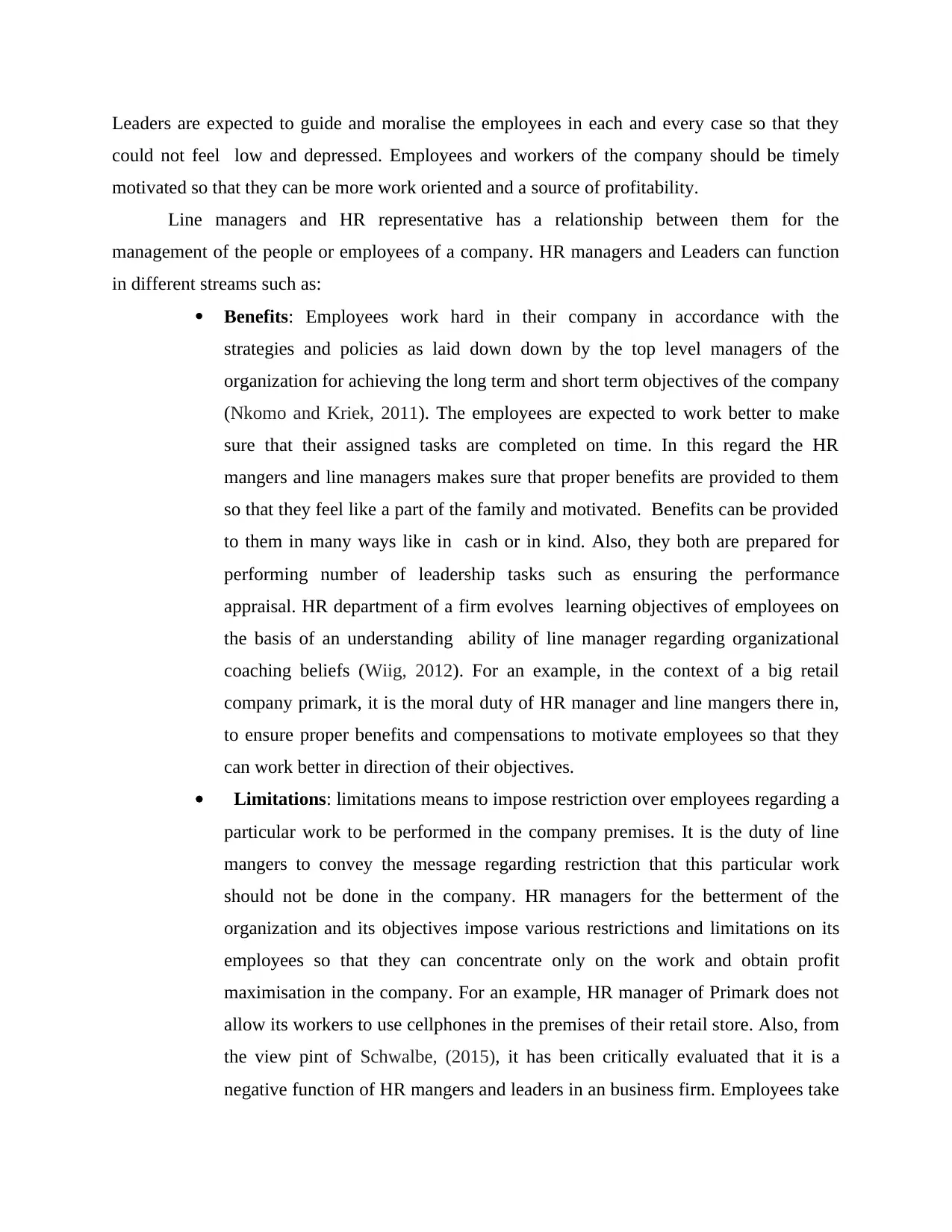
Leaders are expected to guide and moralise the employees in each and every case so that they
could not feel low and depressed. Employees and workers of the company should be timely
motivated so that they can be more work oriented and a source of profitability.
Line managers and HR representative has a relationship between them for the
management of the people or employees of a company. HR managers and Leaders can function
in different streams such as:
Benefits: Employees work hard in their company in accordance with the
strategies and policies as laid down down by the top level managers of the
organization for achieving the long term and short term objectives of the company
(Nkomo and Kriek, 2011). The employees are expected to work better to make
sure that their assigned tasks are completed on time. In this regard the HR
mangers and line managers makes sure that proper benefits are provided to them
so that they feel like a part of the family and motivated. Benefits can be provided
to them in many ways like in cash or in kind. Also, they both are prepared for
performing number of leadership tasks such as ensuring the performance
appraisal. HR department of a firm evolves learning objectives of employees on
the basis of an understanding ability of line manager regarding organizational
coaching beliefs (Wiig, 2012). For an example, in the context of a big retail
company primark, it is the moral duty of HR manager and line mangers there in,
to ensure proper benefits and compensations to motivate employees so that they
can work better in direction of their objectives.
Limitations: limitations means to impose restriction over employees regarding a
particular work to be performed in the company premises. It is the duty of line
mangers to convey the message regarding restriction that this particular work
should not be done in the company. HR managers for the betterment of the
organization and its objectives impose various restrictions and limitations on its
employees so that they can concentrate only on the work and obtain profit
maximisation in the company. For an example, HR manager of Primark does not
allow its workers to use cellphones in the premises of their retail store. Also, from
the view pint of Schwalbe, (2015), it has been critically evaluated that it is a
negative function of HR mangers and leaders in an business firm. Employees take
could not feel low and depressed. Employees and workers of the company should be timely
motivated so that they can be more work oriented and a source of profitability.
Line managers and HR representative has a relationship between them for the
management of the people or employees of a company. HR managers and Leaders can function
in different streams such as:
Benefits: Employees work hard in their company in accordance with the
strategies and policies as laid down down by the top level managers of the
organization for achieving the long term and short term objectives of the company
(Nkomo and Kriek, 2011). The employees are expected to work better to make
sure that their assigned tasks are completed on time. In this regard the HR
mangers and line managers makes sure that proper benefits are provided to them
so that they feel like a part of the family and motivated. Benefits can be provided
to them in many ways like in cash or in kind. Also, they both are prepared for
performing number of leadership tasks such as ensuring the performance
appraisal. HR department of a firm evolves learning objectives of employees on
the basis of an understanding ability of line manager regarding organizational
coaching beliefs (Wiig, 2012). For an example, in the context of a big retail
company primark, it is the moral duty of HR manager and line mangers there in,
to ensure proper benefits and compensations to motivate employees so that they
can work better in direction of their objectives.
Limitations: limitations means to impose restriction over employees regarding a
particular work to be performed in the company premises. It is the duty of line
mangers to convey the message regarding restriction that this particular work
should not be done in the company. HR managers for the betterment of the
organization and its objectives impose various restrictions and limitations on its
employees so that they can concentrate only on the work and obtain profit
maximisation in the company. For an example, HR manager of Primark does not
allow its workers to use cellphones in the premises of their retail store. Also, from
the view pint of Schwalbe, (2015), it has been critically evaluated that it is a
negative function of HR mangers and leaders in an business firm. Employees take
⊘ This is a preview!⊘
Do you want full access?
Subscribe today to unlock all pages.

Trusted by 1+ million students worldwide
1 out of 17
Related Documents
Your All-in-One AI-Powered Toolkit for Academic Success.
+13062052269
info@desklib.com
Available 24*7 on WhatsApp / Email
![[object Object]](/_next/static/media/star-bottom.7253800d.svg)
Unlock your academic potential
Copyright © 2020–2025 A2Z Services. All Rights Reserved. Developed and managed by ZUCOL.





